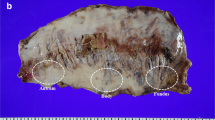Abstract
Background
Little basic science data exists regarding the thickness of transected stomach as the limits of smaller gastric sleeves are created closer to the lesser curvature in laparoscopic sleeve gastrectomy (SG). We sought to determine the tissue thickness trends along the staple line and examine what factors might predispose to thicker tissue.
Methods
This was a single-center, single-surgeon nonrandomized prospective study of patients undergoing SG. Excised SG specimens, with patient consent, underwent tissue measurement at multiple predetermined locations and at the midpoint of each fired staple cartridge.
Results
After 9 months, ending in July 2012, we met our goal enrollment of 50 gastric sleeve specimens. Most of the patients were female (80 %) and white (92.5 %). Average age was 42 years (range, 19–60 years), and average body mass index (BMI) was 49 kg/m2 (range, 34–82 kg/m2). Tissue thickness was significantly different (p < 0.01) at each location, with the antrum being the thickest at 2.70 mm, followed by the midbody at 2.33 mm, and the fundus at 1.97 mm. Both male gender (+0.32 mm, p = 0.04) and BMI over 50 kg/m2 (+0.33 mm, p < 0.01) were associated with thicker tissue, but only in the antrum. The most significant transitions in thickness occurred on the fourth and fifth staple fires, dropping 0.24 mm (p = 0.02) and 0.35 mm (p < 0.01), respectively.
Conclusions
Tissue thickness of excised SG specimens varies on the basis of location with the antrum being the thickest. Both BMI (>50 kg/m2) and gender (male) are associated with increased tissue thickness, but only in the antrum. Surgeons should consider using a thicker staple load, such as black, when these factors are present. Also, significant changes in tissue thickness at the fourth and fifth staple fires suggest stepwise alteration in staple cartridge color selection.


Similar content being viewed by others
References
American College of Surgeons Bariatric Surgery Center Network Database. Bariatric surgery procedure volume by type of case. https://acsbscn.outcome.com/. Accessed Jan 2013
Elariny H, González H, Wang B (2005) Tissue thickness of human stomach measured on excised gastric specimens from obese patients. Surg Technol Int 14:119–124
Baker RS, Foote J, Kemmeter P, Brady R, Vroegop T, Serveld M (2004) The science of stapling and leaks. Obes Surg 14(10):1290–1298
Ethicon.com (2012) Cincinnati: Echelon Flex powered endopath stapler (instructions for use manual). https://www.jnjgatewayifu.com/eLabelingContent/Ees/USENG/P40613P04_6519.pdf. Accessed 1 Mar 2013
Astafiev G (1967) Investigation of tissue processes relating to tissue compression in suturing and stapling apparatus. Surg Staplers 7:22–31
Acknowledgments
This study was financially supported in part by funding from Ethicon Endosurgery (Cincinnati, Ohio) to cover specimen storage and evaluation.
Disclosures
Logan Rawlins, Melissa Rawlins, and Donovan Teel II have no conflicts of interest or financial ties to disclose.
Author information
Authors and Affiliations
Corresponding author
Rights and permissions
About this article
Cite this article
Rawlins, L., Rawlins, M.P. & Teel, D. Human tissue thickness measurements from excised sleeve gastrectomy specimens. Surg Endosc 28, 811–814 (2014). https://doi.org/10.1007/s00464-013-3264-1
Received:
Accepted:
Published:
Issue Date:
DOI: https://doi.org/10.1007/s00464-013-3264-1




